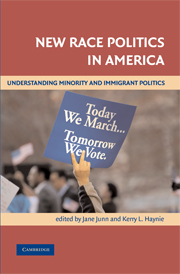Book contents
- Frontmatter
- Contents
- Contributors
- Acknowledgments
- 1 New Race Politics: The Changing Face of the American Electoral Landscape
- 2 In Whose Interest? Political Parties, Context, and the Incorporation of Immigrants
- 3 Beyond Black and White: The Experiences and Effects of Economic Status among Racial and Ethnic Minorities
- 4 Activity amid Diversity: Asian American Political Participation
- 5 Get Me to the Polls on Time: Coethnic Mobilization and Latino Turnout
- 6 Se Habla Espanol: Ethnic Campaign Strategies and Latino Voting Behavior
- 7 Structuring Group Activism: A Macro Model of Black Participation
- 8 Black Elites and Latino Immigrant Relations in a Southern City: Do Black Elites and the Black Masses Agree?
- 9 Understanding the New Race Politics: Conclusions and Challenges
- References
- Index
9 - Understanding the New Race Politics: Conclusions and Challenges
Published online by Cambridge University Press: 05 September 2012
- Frontmatter
- Contents
- Contributors
- Acknowledgments
- 1 New Race Politics: The Changing Face of the American Electoral Landscape
- 2 In Whose Interest? Political Parties, Context, and the Incorporation of Immigrants
- 3 Beyond Black and White: The Experiences and Effects of Economic Status among Racial and Ethnic Minorities
- 4 Activity amid Diversity: Asian American Political Participation
- 5 Get Me to the Polls on Time: Coethnic Mobilization and Latino Turnout
- 6 Se Habla Espanol: Ethnic Campaign Strategies and Latino Voting Behavior
- 7 Structuring Group Activism: A Macro Model of Black Participation
- 8 Black Elites and Latino Immigrant Relations in a Southern City: Do Black Elites and the Black Masses Agree?
- 9 Understanding the New Race Politics: Conclusions and Challenges
- References
- Index
Summary
With significant waves of new immigration to the United States, overwhelmingly from Asia and Latin America, the electoral significance of minority voters is becoming increasingly apparent. As the studies in this volume make clear, how increases in the racial and ethnic diversity of the voting public will influence political representation, policy outcomes, and democratic politics, more generally, remains to be seen. For example, despite the growing size of minority groups in the United States, political representation by minority officials lags far behind their numbers in the population. The 109th Congress, elected in 2004, is a specific case in point. This Congress is the most racially diverse Congress in the history of the United States. That year, voters sent a record number of minority Americans to both the United States House and Senate. The 109th House of Representatives included forty-two African Americans, twenty-four Latinos, five Asian Americans, and one American Indian, whereas the 109th Senate had one African American, two Asian Americans, and two Latinos. Nevertheless, the Senate and the House were 95 percent and 83 percent white, respectively. At the same time, nearly one-third of the U.S. population considered itself to be a race other than white. One of the most intriguing questions for the new race politics of the United States in the twenty-first century is whether those proportions will change as a function of changing patterns in minority and immigrant voting.
- Type
- Chapter
- Information
- New Race Politics in AmericaUnderstanding Minority and Immigrant Politics, pp. 166 - 174Publisher: Cambridge University PressPrint publication year: 2008
- 1
- Cited by



